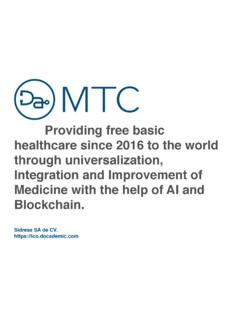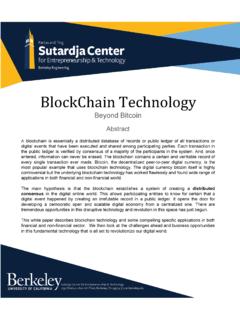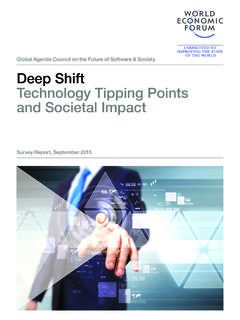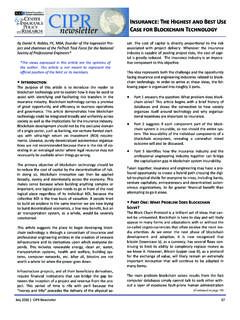Transcription of Blockchain in insurance: applications and pursuing …
1 Blockchain in insurance : applications and pursuing a path to adoption1| Blockchain in insuranceBlockchain has the potential to evolve into a core, underlying element in the technology stacks of most P&C carriers, supporting a diverse range of processes and part of your company s future technology plumbing. Blockchain , or distributed ledger technology, has quickly become a fixation in the financial services industry as a result of its potential to revolutionize and transform our thinking about data sharing and security. In considering the technology, senior business and IT leaders at property and casualty (P&C) companies must balance their natural skepticism about next big thing trends with a clear recognition of both the large-scale impacts and significant upside. After all, it s not hype to say that the value creation opportunity is huge and the possibilities of future applications are many.
2 Similarly, it s not hard to see how distributed, secure, peer-to-peer ledgers the mysterious and exotic-sounding technology behind Blockchain may one day be as common in the insurance industry as Structured Query Language (SQL) databases. Blockchain has the potential to evolve into a core, underlying element in the technology stacks of most P&C carriers, supporting a diverse range of processes and part of your company s future technology plumbing. P&C executives must also keep in mind that these are still very early days. Blockchain in 2016 is roughly where the World Wide Web was in 1996 on the radar of forward-thinking companies, but still a long way from adoption at scale. Therefore, the question for most P&C companies is not whether they will adopt Blockchain , but rather what and how to start testing and proving out the value proposition.
3 2 Blockchain in insurance |3| Blockchain in insuranceBelow, we look at emerging Blockchain applications and five key areas where we see the most potential for transformations and disruptions to play out. Fraud detection and risk preventionThanks to its ability to provide a public ledger across multiple untrusted parties, Blockchain has the potential to eliminate errors and detect fraudulent activity. A decentralized digital repository can independently verify the authenticity of customers, policies and transactions (such as claims) by providing a complete historical record. As such, insurers would be able to identify duplicate transactions or those involving suspicious insurers (including some outside of P&C) are already exploring the use of Blockchain to reduce fraud and risks associated with payments across borders and transactions involving multiple currencies.
4 In specialty insurance and reinsurance markets, where insurers are often removed from the end clients, Blockchain may be used to address the considerable inefficiencies, gaps and errors caused by poor data quality in both front and back offices. Health insurers and regulators in the US view Blockchain as a powerful tool for combating Medicare fraud. Validation and verification, which can add value to many insurance processes, form the heart of the Blockchain business case. Claims prevention and managementAlongside big data, mobile and digital technologies, Blockchain is essential to establishing an efficient, transparent and customer-focused claims model based on higher degrees of trust. Within claims prevention, new data streams can enhance the risk selection process by combining location, external risk and analytics.
5 A distributed ledger can enable the insurer and various third parties to easily and instantly access and update relevant information ( , claim forms, evidence, police reports and third-party review reports).The use of data from a mobile phone or sensors can streamline claims submission, reduce loss adjuster costs and increase customer satisfaction, with Blockchain systems facilitating communications and coordination among all parties. Consider how sensors can trigger alerts to insurers that a crash has occurred (thereby initiating a new claim), and then route secure and relevant data to preapproved and conveniently located medical teams, towing services and/or repair garages. Here again, Blockchain is the network connecting and ordering data from the multiple devices and apps involved in the multidimensional process.
6 Similarly, the combination of sensor data, satellite imagery, mobile technologies and Blockchain could be used to facilitate claims payments and rescue services when natural disasters occur in remote areas. Data from weather stations could determine claims amounts based on actual weather readings, with Blockchain enabling greater automation, more efficient data sharing and stronger safeguards against fraud. 124 Blockchain in insurance |Internet of Things (IoT) and product developmentAs more devices and objects are connected to the IoT, the amount of data that will be created and collected will increase significantly. This data will be hugely valuable to insurers as they look to develop more accurate actuarial models, or new products such as usage-based insurance (UBI) models. In the auto insurance market, for example, consider how encrypted data gathered about driving times and distances, acceleration and braking patterns, and other behaviors can be used to identify high-risk drivers, validate information included on applications and give consumers more control over their challenge in this future state, however, is how to manage the sheer volume of data and logic as thousands or millions of devices are communicating with each other.
7 With Blockchain , you can manage large, complex networks by having the devices communicate and manage each other on a peer-to-peer basis, securely, instead of building an expensive data center to handle the processing and storage load. Having these devices manage themselves is significantly cheaper than the data center distribution and payment modelsA number of global insurers are developing alliances and exploring new payment business models (and bitcoin technologies) to achieve capital efficiencies through single global ledgers. Increased automation to capture risk data in contracts also offers new opportunities to build market knowledge, streamline payments and attract financing risk. At minimum, global insurers can use Blockchain to cut asset management costs by reducing the hedging fees they pay to protect themselves from currency fluctuations in international wallets are another potential use case.
8 Insurers developing these offerings typically restrict consumers options and limit the data that can be included. With Blockchain , wallets can achieve customer engagement on a much greater scale, with tailored functionalities and more integrated data. Consumers could have all their identities and insurance information available P&C insurers seeking clearer visibility into their reinsurance contracts and risk exposures may gain it through Blockchain . Consider the case of an insurer seeking to offload an equal amount of risk to two separate reinsurers. A Blockchain ledger could provide insight and notification if one of those reinsurers then tried to offload some of its portion to a subsidiary of the other reinsurer. It also would help insurers gain confidence that, as they pay out claims, they are appropriately rebalancing their capital exposures against specific risks.
9 Within reinsurance, the benefits of Blockchain include more accurate reserve calculations based on actual participating contracts and automatic calculation updates once underlying data is updated. Plus, insurers gain more flexibility in moving capital and enhanced transparency into known risks, capital efficiency and capital requirements for compliance. Practically speaking, audit trails become easier to follow, modeling requirements are greatly reduced and there is less need for coordination between finance and IT. 3455| Blockchain in insuranceThe three-step path to adoption and maturationAfter identifying high-impact areas for Blockchain technology, insurance companies should begin testing and proving out new models. We see a fairly clear path forward in this regard, starting with low-risk, internal prototypes and pilots in the short term, later expanding to broader deployments involving partners and third-party networks.
10 As with firms in other industries, the adoption curve for P&C insurers involves evolution from internally focused projects to customer-facing ones and, ultimately, to widespread adoption enabled by the IoT. Internal proofs of conceptFor many insurers, a simple, internally focused use case will be the right place to start. Internal reconciliation of customer data sets and internal claims processing with smart contracts are two likely candidates for experimentation. The opportunity to streamline internal processes, such as monthly closes, may also be attractive. By choosing narrow-scope projects to address internal business gaps in the short term, you position your organization with the right insights and strategies to appropriately address the larger opportunities and business issues down the road. Customer-facing processesAs the technology progresses and internally deployed solutions verify the viability and functionality of Blockchain solutions, insurers will next turn to implementations that support customer-facing applications .

















